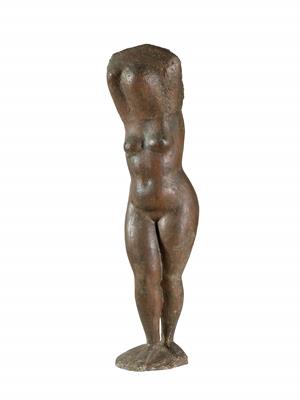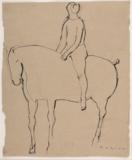Marino Marini *

(Pistoia 1901–1980 Viareggio)
‘Danzatrice’, 1945, bronze with dark gilt patina, one of three unnumbered casts, 134 x 40 x 35 cm, (MCC)
This work is registered at the Fondazione Marino Marini, Pistoia as archive no. 137 (29/11/2002).
Provenance:
The artist
Nino (1889 – 1971) und Pasquarosa Marcelli Bertoletti (1896 – 1973) Collection, Rome
Private Collection, Italy – acquired there by the present owner
Exhibitions:
Tokyo, Marino Marini, The National Museum of Modern Art, April - June 1978
Tokyo, Marino Marini, Sculture, dipinti e disegni, Station Gallery, November 1997 - January 1998
Literature:
R. Carrieri, Marino Marini Scultore, ed. del Milione, Milan, 1948, no. 61 with ill.
U. Apollonio, Marino Marini scultore, ed. il Milione, 1953, plate no. 58
P. Waldberg/H. Read/G. di San Lazzaro, Marino Marini, l’opera completa, Silvana edit., Milan, 1970, page 141, c. sn. no. 194 with ill.
C. Pirovano, Marino Marini-Scultore, Electa, Milan, 1972, csn. 202
G. Gentile, Marino Marini, Pomone e Nudi femminili, Milan, 1991, plates 5, 6 and 7
Fondazione Marino Marini, Marino Marini, Catalogo ragionato della scultura, Skira, Milan, 1998, p. 186, no. 267B with ill.
Works held in public collections:
The other two casts of this bronze form part of the following collections:
Fondazione Marino Marini, Palazzo del Tau, Pistoia; Tel Aviv
Museum of Art, Tel Aviv
Around 1938 Marino began to create female nudes that, from the 1940s onwards, would develop a lush carnal opulence. This feature, in Marino’s words, reveals ‘femininity enriched by all its remotest, most immanent and most mysterious meanings: a kind of inevitable necessity of immovable firmness, of primitive and unconscious fertility.’ Marino’s art is deeply rooted in Mediterranean classicism. His female nudes are inspired by Pomona, the Etruscan goddess of fertility, who for the artist becomes the symbol of a harmonious and sheltered rural world. Marino executed about ten figures, mainly in bronze; an absolute masterpiece among them is that of 1941 in the Uffizi Gallery, in which the lack of a head and arms enhances the complete structural unity of its masses, large and soft at once, as if levitating in space. After spending the war years in exile in Switzerland, where he came into contact with Giacometti, Wotruba and Richier, Marino Marini returned to Milan and resumed both academic teaching and his favourite sculptural themes, such as Pomona, dancers, acrobats and riders, enhancing their expressive effects by means of signs that are not only elements of form but also of content. Marini conceived new volumes and clear-cut forms and used materials such as plaster, terracotta and wood with energetically painted, scratched and corroded surfaces.
The interplay of surfaces and sculptural masses attempts to solve the problem of light with refined sensibility. As Lionello Venturi writes, ‘structural plasticity within and atmospheric vibration on the surface are both necessary to him: the former, in order to instil energy, and the latter, in order to obtain vitality and delicacy.’ In the case of the bronzes depicting dancers, this dual stylistic intent produces effects of extraordinary quality. In his presentation of the room dedicated to Marino Marini at the Venice Biennale in 1952, Marco Valsecchi described this aspect with great precision.
The female figure, ‘with its mighty hips, appears completely absorbed in the harmonious detachment of its curves; and yet, a simple gesture – the movement of an arm, the bending of a leg, the turning of the head towards a sudden, mysterious noise from above – is enough to reverberate rhythmically through the surrounding air.’ The elegant and mysterious detail characterising the present ‘Dancer’ is the absence of the face, which is left entirely to the viewer’s intuition, thus stimulating his imagination.
Expert: Maria Cristina Corsini
 Maria Cristina Corsini
Maria Cristina Corsini
+39-06-699 23 671
maria.corsini@dorotheum.it
09.06.2015 - 19:00
- Dosažená cena: **
-
EUR 186.000,-
- Odhadní cena:
-
EUR 150.000,- do EUR 200.000,-
Marino Marini *
(Pistoia 1901–1980 Viareggio)
‘Danzatrice’, 1945, bronze with dark gilt patina, one of three unnumbered casts, 134 x 40 x 35 cm, (MCC)
This work is registered at the Fondazione Marino Marini, Pistoia as archive no. 137 (29/11/2002).
Provenance:
The artist
Nino (1889 – 1971) und Pasquarosa Marcelli Bertoletti (1896 – 1973) Collection, Rome
Private Collection, Italy – acquired there by the present owner
Exhibitions:
Tokyo, Marino Marini, The National Museum of Modern Art, April - June 1978
Tokyo, Marino Marini, Sculture, dipinti e disegni, Station Gallery, November 1997 - January 1998
Literature:
R. Carrieri, Marino Marini Scultore, ed. del Milione, Milan, 1948, no. 61 with ill.
U. Apollonio, Marino Marini scultore, ed. il Milione, 1953, plate no. 58
P. Waldberg/H. Read/G. di San Lazzaro, Marino Marini, l’opera completa, Silvana edit., Milan, 1970, page 141, c. sn. no. 194 with ill.
C. Pirovano, Marino Marini-Scultore, Electa, Milan, 1972, csn. 202
G. Gentile, Marino Marini, Pomone e Nudi femminili, Milan, 1991, plates 5, 6 and 7
Fondazione Marino Marini, Marino Marini, Catalogo ragionato della scultura, Skira, Milan, 1998, p. 186, no. 267B with ill.
Works held in public collections:
The other two casts of this bronze form part of the following collections:
Fondazione Marino Marini, Palazzo del Tau, Pistoia; Tel Aviv
Museum of Art, Tel Aviv
Around 1938 Marino began to create female nudes that, from the 1940s onwards, would develop a lush carnal opulence. This feature, in Marino’s words, reveals ‘femininity enriched by all its remotest, most immanent and most mysterious meanings: a kind of inevitable necessity of immovable firmness, of primitive and unconscious fertility.’ Marino’s art is deeply rooted in Mediterranean classicism. His female nudes are inspired by Pomona, the Etruscan goddess of fertility, who for the artist becomes the symbol of a harmonious and sheltered rural world. Marino executed about ten figures, mainly in bronze; an absolute masterpiece among them is that of 1941 in the Uffizi Gallery, in which the lack of a head and arms enhances the complete structural unity of its masses, large and soft at once, as if levitating in space. After spending the war years in exile in Switzerland, where he came into contact with Giacometti, Wotruba and Richier, Marino Marini returned to Milan and resumed both academic teaching and his favourite sculptural themes, such as Pomona, dancers, acrobats and riders, enhancing their expressive effects by means of signs that are not only elements of form but also of content. Marini conceived new volumes and clear-cut forms and used materials such as plaster, terracotta and wood with energetically painted, scratched and corroded surfaces.
The interplay of surfaces and sculptural masses attempts to solve the problem of light with refined sensibility. As Lionello Venturi writes, ‘structural plasticity within and atmospheric vibration on the surface are both necessary to him: the former, in order to instil energy, and the latter, in order to obtain vitality and delicacy.’ In the case of the bronzes depicting dancers, this dual stylistic intent produces effects of extraordinary quality. In his presentation of the room dedicated to Marino Marini at the Venice Biennale in 1952, Marco Valsecchi described this aspect with great precision.
The female figure, ‘with its mighty hips, appears completely absorbed in the harmonious detachment of its curves; and yet, a simple gesture – the movement of an arm, the bending of a leg, the turning of the head towards a sudden, mysterious noise from above – is enough to reverberate rhythmically through the surrounding air.’ The elegant and mysterious detail characterising the present ‘Dancer’ is the absence of the face, which is left entirely to the viewer’s intuition, thus stimulating his imagination.
Expert: Maria Cristina Corsini
 Maria Cristina Corsini
Maria Cristina Corsini
+39-06-699 23 671
maria.corsini@dorotheum.it
|
Horká linka kupujících
Po-Pá: 10.00 - 17.00
kundendienst@dorotheum.at +43 1 515 60 200 |
| Aukce: | Moderní |
| Typ aukce: | Salónní aukce |
| Datum: | 09.06.2015 - 19:00 |
| Místo konání aukce: | Wien | Palais Dorotheum |
| Prohlídka: | 30.05. - 09.06.2015 |
** Kupní cena vč. poplatku kupujícího a DPH
Není již možné podávat příkazy ke koupi přes internet. Aukce se právě připravuje resp. byla již uskutečněna.
Další objekty umělce
-

Odhadní cena:
EUR 10.000,- do EUR 15.000,-
Všechny objekty umělce
